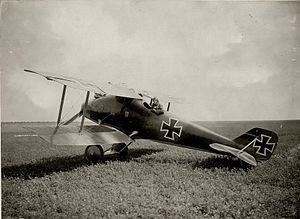Loading AI tools
1910s German fighter aircraft From Wikipedia, the free encyclopedia
The LFG Roland D.II was a German single-seat fighter of World War I. The type was manufactured by Luftfahrzeug Gesellschaft, and also by Pfalz Flugzeugwerke under license.
| Roland D.II | |
|---|---|
 | |
| Role | Fighter |
| Manufacturer | Luft-Fahrzeug-Gesellschaft, Pfalz |
| First flight | October 1916 |
| Introduction | Early 1917 |
| Number built | 300 |
| Developed from | Roland D.I |
The D.II used a plywood monocoque fuselage. Two layers of plywood strips were spirally wrapped in opposing directions over a mold to form one half of a fuselage shell. The fuselage halves were then glued together, covered with a layer of fabric, and doped. This design, which was known as the Wickelrumpf, allowed the creation of a smooth, strong and light structure.[1] The upper wing was attached to the fuselage by means of a large central pylon, greatly impairing the pilot's forward vision. Armament consisted of twin "Spandau" LMG 08/15 machine guns buried in the fuselage decking.
The D.II was initially powered by a 160 hp Mercedes D.III engine, giving a top speed of 105 mph at sea level. Later aircraft, designated D.IIa, were powered by a 180 hp Argus As.III. The As.III offered poor performance above 3,000 m and the D.IIa was mostly relegated to operations on the Eastern Front.
Nicknamed Haifisch (shark) for its sleek appearance, the D.II and D.IIa proved generally unpopular in service due to poor fields of view and heavy controls. It was quite fast and strong, but had mediocre manoeuvrability and handling.[1] However, it is also reported that the aircraft had particularly sensitive controls, particularly in the yawing plane.[2] The type is known to have been used by Jasta 25 at their Canatlarzi base in Macedonia in 1917.

Data from German Aircraft of the First World War [3]
General characteristics
Performance
Armament
Related development
Aircraft of comparable role, configuration, and era
Related lists
Seamless Wikipedia browsing. On steroids.
Every time you click a link to Wikipedia, Wiktionary or Wikiquote in your browser's search results, it will show the modern Wikiwand interface.
Wikiwand extension is a five stars, simple, with minimum permission required to keep your browsing private, safe and transparent.